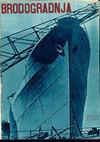内河货船营运能源效率
IF 4.2
4区 工程技术
Q1 ENGINEERING, MARINE
引用次数: 1
摘要
内河船舶(IWV)没有像远洋船舶那样对其能源效率进行强制性规定。到目前为止,只有两种拟议的设计能效评估方法,均基于IMO EEDI方法和欧盟内河航运数据。现有文献中的操作指标和实时导航测量不存在。因此,本文旨在介绍多瑙河典型货船的运行能效评估。首先,通过跟踪船只的航行,并通过识别船只在指定时间内航行的每个扇区的实际约束,来获取操作概况。其次,将EEO纳入两种可用的方法中,并根据获取的作战数据考虑不同的航行条件进行计算。本文展示了能源效率在很大程度上取决于水深、流速、吃水、自重和河流约束等变量。分析针对船舶航行中使用人数最多的月份和每年进行。根据水位情景和选定的航行月份,二氧化碳排放总量估计在22.7吨至29.9吨之间,而为了符合要求,每个部门航程所需的平均减速(即慢航)计算在4.8%-26%之间。慢航被评估为每月延长6.1-10.7小时,每年延长49-87小时。本文章由计算机程序翻译,如有差异,请以英文原文为准。
Inland waterway cargo vessel energy efficiency in operation
Inland waterways vessels (IWV) have no mandatory regulations regarding their energy efficiency, as sea-going ships have. So far, there are just two proposed design energy efficiency evaluation methods, both based on IMO EEDI approach and data on EU inland navigation. Operational indicators and real-time navigation measurements from available literature do not exist. Therefore, this paper aims to introduce the energy efficiency in operation (EEO), assessed for the typical Danube cargo vessel. Firstly, an operational profile is acquired by tracking the vessel’s voyages, and by identifying actual constraints of each sector the vessel has sailed during the designated time. Secondly, EEO is incorporated within two available methods and calculated based on acquired operational data considering different navigational conditions. The paper shows how the energy efficiency vastly depends on variables such as water depth, current speed, draught, deadweight, river constraints. Analysis is performed for the most employed month of the vessel navigation, and annually. Depending on water level scenarios and during the selected month of sailing, the total amount of CO2 emitted is estimated to be between 22.7 t and 29.9 t, while the necessary average speed reduction (i.e., slow steaming) per sectoral voyage for the requirement compliance is calculated to be in between 4.8%-26%. Slow steaming is assessed to extend the time of voyage for 6.1-10.7 hours on monthly basis and 49-87 hours annually.
求助全文
通过发布文献求助,成功后即可免费获取论文全文。
去求助
来源期刊

Brodogradnja
ENGINEERING, MARINE-
CiteScore
4.30
自引率
38.90%
发文量
33
审稿时长
>12 weeks
期刊介绍:
The journal is devoted to multidisciplinary researches in the fields of theoretical and experimental naval architecture and oceanology as well as to challenging problems in shipbuilding as well shipping, offshore and related shipbuilding industries worldwide. The aim of the journal is to integrate technical interests in shipbuilding, ocean engineering, sea and ocean shipping, inland navigation and intermodal transportation as well as environmental issues, overall safety, objects for wind, marine and hydrokinetic renewable energy production and sustainable transportation development at seas, oceans and inland waterways in relations to shipbuilding and naval architecture. The journal focuses on hydrodynamics, structures, reliability, materials, construction, design, optimization, production engineering, building and organization of building, project management, repair and maintenance planning, information systems in shipyards, quality assurance as well as outfitting, powering, autonomous marine vehicles, power plants and equipment onboard. Brodogradnja publishes original scientific papers, review papers, preliminary communications and important professional papers relevant in engineering and technology.
 求助内容:
求助内容: 应助结果提醒方式:
应助结果提醒方式:


